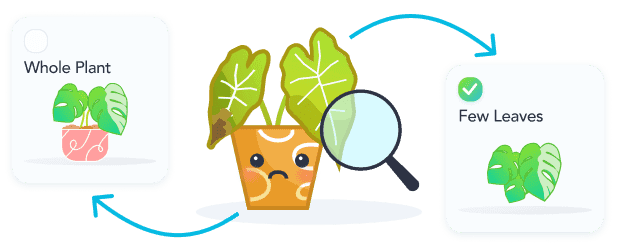Every 7d
Recommended Frequency
1 /2 cup of water
Recommended Amount
Water your Tradescantia Nonouk once a week, making sure the soil has dried out between waterings.
Every 30d
Recommended Frequency
Fertilize your Tradescantia Nanouk once a month during spring and summer using a liquid fertilizer diluted by half.
Indirect Sun
Recommended
Indirect Sun or Filtered Sun is when sun exposure is being filtered through a sheer curtain or is not able to have the sun's rays directly hit the leaves/flowers of your plant.
Every 730d
Recommended Frequency
Repot your Tradescantia Nanouk every two years, or once it outgrows its pot.
For optimal growth, Tradescantia Nanouk thrives in temperatures between 75 to 85 degrees Fahrenheit, placing it in a moderate to high temperature preference. Ensure it's kept within this range for health.
Peat Soil
Recommended Soil
Peat Soil is an acidic soil that retains a lot of moisture and slows decomposition. Due to such a high moisture retention this mix may require irrigation to help with draining. This soil type is best used when paired wit...

Shop Tradescantia Nanouk
Questions about Tradescantia Nanouk
The Tradescantia Nanouk, also known as Fantasy Venice, is a vibrant, fast-growing plant characterized by its striking pink, green, and white leaves. It's a hybrid plant developed for its unique coloration and robust grow...

Toxicity of Tradescantia Nanouk

Common Pests and Diseases
Root Rot
Overwatering
To address root rot in Tradescantia Nanouk, first, stop watering immediately and allow the soil to dry out. If the plant is severely affected, remove it from its pot, trim away any black, mushy roots, and repot in fresh, well-draining soil. Ensure the pot has adequate drainage holes. Going forward, water only when the top inch of soil feels dry to the touch, and avoid letting the plant sit in waterlogged conditions.
Leaf Curling and Drooping
Underwatering
Tradescantia Nanouk requires consistent moisture to thrive but is also susceptible to overwatering. To address underwatering, establish a regular watering schedule, ensuring the soil is moist but not soggy. Check the soil moisture by inserting your finger about an inch deep; if it feels dry, it's time to water. Consider using a pot with drainage holes to prevent waterlogging. During hotter months, you may need to water more frequently. Adjust your watering schedule according to the season and your indoor environment.
Spider Mite Infestation
Spider mites are tiny pests that thrive in warm, dry conditions. They feed on the sap of the Tradescantia Nanouk, causing yellowing, speckled leaves, and webbing on the plant.
To combat spider mites, start by isolating the affected plant to prevent the mites from spreading. Increase humidity around the plant, as spider mites prefer dry conditions. Wash the plant gently with water to remove some of the mites. For severe infestations, use a neem oil solution or insecticidal soap, applying it directly to the leaves, especially the undersides, where mites tend to congregate. Repeat the treatment every 7-10 days until the infestation is under control.
Fungal Leaf Spot
Caused by a variety of fungal pathogens, this issue often arises in conditions of high humidity combined with poor air circulation around the plant.
To address fungal leaf spot, start by removing any affected leaves to prevent further spread. Improve air circulation around your Tradescantia Nanouk by not overcrowding plants and consider using a fan if indoor air is stagnant. Lower humidity levels around the plant, especially if you're growing it indoors. As a preventive measure, avoid wetting the leaves when watering. If the problem persists, apply a fungicide suitable for indoor plants, following the manufacturer's instructions carefully.

Related Plants
Other Articles:
Top 10 Most Popular Roses
Mar 22, 2022
How to Care for China Roses
Mar 11, 2022
How to Care for Chinese Money Plants
May 15, 2020
How to Grow and Care for A Bird of Paradise
Apr 26, 2020
Top 10 Plants To Grow In A Terrarium
May 31, 2022
How to Grow and Care for Lucky Bamboo
Mar 29, 2022
How to Grow and Care for Corn Plants
Mar 29, 2022
How to Care for Madagascar Dragon Trees
Mar 21, 2022



